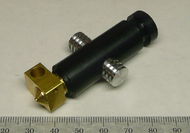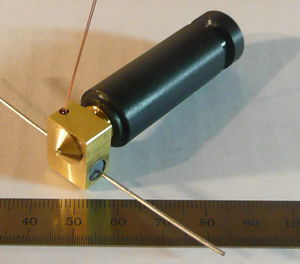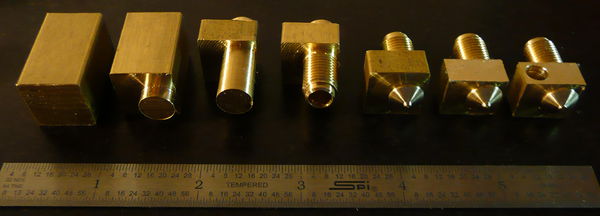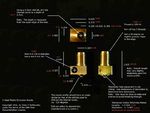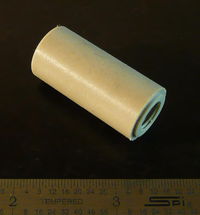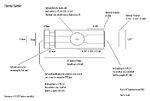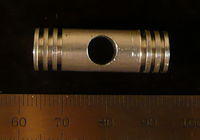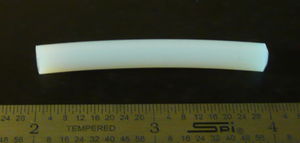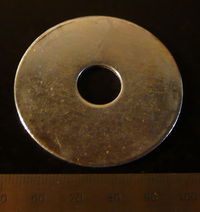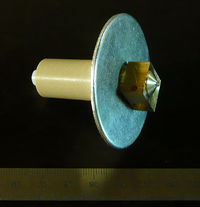J Head Nozzle
Release status: working
| Description | J-Head Nozzle and Thermal Barrier Based on a combination of ideas from the Makerbot Mk 5 hot end, The Inline Heater Variation, some ideas from Brian Briggs, and some ideas from me.
|
| License | GPL
|
| Author | |
| Contributors | |
| Based-on | |
| Categories | |
| CAD Models | |
| External Link |
Introduction
This nozzle is a combination of ideas from other nozzle designs combined with a goal to reduce the number of custom machined parts to a bare minimum. By reducing the number of machined parts, it is hoped that the cost of this hot-end can be kept down while improving the reliability.
The use of a machined piece of round PTFE, as a liner, was requested in one of two designs by Brian Briggs.
The idea of using the PTFE tubing as a liner, from the Cold End to the tip, was borrowed from the Makerbot Mk V extruder design.
The PTFE tubing also acts to "bridge" the joint between the PEEK insulator and the brass nozzle/heater. By not having the filament in contact with this joint it is hoped that any possibility of leakage will be completely eliminated.
The use of a combination heater and nozzle was borrowed from GilesBathgate's Inline Heater Nozzle Variation. However, instead of the heater resistor being mounted parallel to the path of the filament it is mounted perpendicular to the path of the filament. This was done to both reduce the length of the nozzle and to make it a little easier to run the leads from the heater resistor. Combining the heater and nozzle also helped to meet the goal to keep the number of custom machined parts to a minimum.
Advantages
- Internally, the filament path is identical to that of an already proven design.
- The design is simple as there are only two machined parts. (If the optional experimental heat sink is added, there are 3 machined parts.)
- If necessary, the PTFE liner can be replaced by using an off-the-shelf piece of PTFE tubing.
- PTFE is not stressed nor used to provide support. This reduces a point of failure that is part of other designs.
- A resistor is used as a heater. There is no need to wrap nichrome wire.
- Heat transmission is improved as there is no thermal junction where a separate heater screws onto the nozzle.
Disadvantages
- The brass nozzle requires considerable machining.
Parts List
| Quantity | Part | Description | Part Number |
| 1 | J-Head Nozzle | Machined Brass Nozzle/Heater Combination | |
| 1 | Thermal Barrier | Machined PEEK Insulator | |
| 1 | Heat Sink | Optional Experimental Machined Aluminum Heat Sink | |
| 1 | PTFE liner | 1/8" ID, 1/4" OD PTFE tubing | McMaster-Carr 5033K31 |
| 1 | Heater Resistor | Axial, 5.6 ohm, 1%, 5W | UB5C-5.6-ND |
| 1 | Thermistor | 100K | B57560G104F |
| 1 | Support Washer | Optional 1/2" Fender Washer | McMaster-Carr 91090A114 |
| 1 | Hollow-lock socket set screw | Optional 5/16-24 hollow-lock socket set screw | McMaster-Carr 91301A150 |
Machined Parts
J-Head Nozzle
Material: Brass Bar Stock, 5/8" Square Or 5/8" x 1/2" Rectangular, 1.125" Long
Note: These instructions differ from the machining example displayed in the above picture and are only one example of how the nozzle can be machined. The machining process can vary depending upon available machinery and tooling. The minimum machining requirements are a metal lathe with a 4-jaw independent chuck.
- Cut a piece of brass bar stock 1.125" long plus enough to adequately hold the stock in the lathe.
- On the brass bar stock, find the center of the axis of the nozzle. This can be done by various means ranging from using a milling machine to using marking fluid, a height gauge, and a surface plate.
- Mount the brass bar stock in a 4-jaw chuck on a lathe. Adjust the chuck so that the nozzle axis is on center.
- Turn the threaded end of the nozzle down to 0.375 +0.000 -0.004.
- Thread the nozzle to 3/8-24 up to the shoulder of the heater section.
- Drill out the center of the nozzle using a 6.5mm drill bit.
- Turn off the last 3 threads, at the end of the nozzle, and cleanup the threads.
- Cut a 30 degree taper on the very end of the threaded end of the brass nozzle. This is to completely eliminate the internal gap between the brass nozzle and the PEEK thermal barrier. This gap would exist due to the internal taper created by the cutting edge of the drill bit.
- Remove the work piece and mount it by the threaded end so that the threaded end is centered in the lathe.
- Cut-off any excess material.
- Machine the nozzle tip to the desired profile.
- Drill the nozzle orifice.
- Mill or turn off the excess material in the heater section. This can be accomplished by mounting the nozzle in the 4-jaw chuck sideways so that the excess material is presented for machining. If available, a milling machine can also be used. (If a 5/8" x 1/2" piece of bar stock is used, this step will be skipped.)
- Using a letter size A drill bit, drill out the hole for the heater resistor.
- Drill out the hole for the thermistor.
Thermal Barrier
Material: PEEK, 5/8" Round, 36.5mm Long Or 50mm Long
Note: The length can be increased, if necessary. (i.e. Increase the length to 50mm for the Sells Mendel and/or if the heat-sink is going to be installed.) All dimensions on the hot-end side, of the thermal barrier, would remain the same.
- Cut a piece of 5/8" round PEEK to length.
- Drill out the PEEK using a 6.5mm drill bit.
- Using a letter size Q drill bit, enlarge one end to a depth of 0.450 +-0.005.
- Internally thread the end to 3/8-24 using a bottom tap.
- (Optional) Turn a 0.500 -0.000 +0.005 shoulder for a distance of approximately 0.050. (This will keep the support washer centered and insulated from the brass nozzle.)
- (Optional) Thread the cold-end for a hollow-lock socket set screw.
- Using a letter size I drill bit, drill out the cold end for a distance of 0.200.
- Internally thread the cold end to 5/16-24. (A special bottom tap has to be ground in order to finish threading this hole. This tap will not have any incomplete threads.)
- (Optional) 4.76mm from the cold-end, turn a groove that is 4.64mm wide with an OD of 12mm.
- (Optional) Using a 3/8" drill bit, drill heat-sink hole 0.787 -0.000 +0.040 from the hot-end.
Heat Sink
(Experimental)
Material For 4 Fin Heat Sink: Aluminum, 3/8" Round, 1.000" Long
Material For 6 Fin Heat Sink: Aluminum, 3/8" Round, 1.160" Long
Note: This item is an optional experimental addition and may be of help when printing with PLA. It is possible that more fins may need to be added.
- Cut a piece of 3/8" round aluminum to length.
- Using a 1mm (0.040) cutoff tool, make 2 or 3 grooves in each end. The grooves will be 0.050 deep and 1mm apart.
- Cross-drill the PTFE liner hole with a 6.5mm drill bit. This hole is to be centered in both directions.
Modifying the Thermal Barrier:
Note: Due to there being slightly less than 12mm clearance with a 36.5mm thermal barrier, between the cold-end of the thermal barrier and the heat sink, using a 50mm thermal barrier is advisable. (Different thermal barrier lengths are shown in the above pictures.)
- If it is desirable to orient the heat sink in a certain direction relative to the brass nozzle, install the brass nozzle.
- Using a 3/8" drill bit, cross-drill the PEEK thermal barrier so that the center of the hole is 0.787 -0.000 +0.040 from the hot end.
PTFE Liner
Material: PTFE tubing, 0.250" OD, 0.125" ID
- Using a razor knife, cut the tubing to desired length. The length is dependent upon the length of the thermal barrier used.
- Cut an approximately 30 degree (or greater) taper on what will be the hot-end of the PTFE liner.
Note: The prototype nozzle has worked without this taper. However, the taper would not have to be too precise as PTFE is quite flexible. If a lathe is not available, it may be possible to cut a workable taper with a pencil sharpener.
Support Washer
The support washer is optional. It can be drilled out with 3mm holes and M3 threaded rod can be used in order to provide additional support for the hot-end. If the support washer is not used, the PEEK thermal barrier can be secured in the extruder by using other means.
Assembly
- If the optional heat-sink is going to be used, install the heat-sink. The heat-sink will probably need to be pressed in place. Care must be taken to ensure that the heat-sink liner passage is properly aligned with the thermal barrier liner passage. After the heat-sink is installed, ensure that the liner passage is clear of any debris.
- Secure the brass nozzle in a vise by the heater section.
- Optionally, install the support washer. If the support washer is to be used, drill the appropriate holes for the support rods prior to installation. (Note: The above pictures do not have holes drilled as it is possible that the hole locations could vary.)
- Screw the PEEK thermal barrier down onto the nozzle. If necessary, use a pair of pliers to tighten the nozzle. The PEEK can be protected from the pliers by first wrapping it with a rag or paper towel.
- Using a dental pick, straightened out paper clip, small screw driver, etc., ensure that the PEEK is screwed down all the way by feeling for an internal gap between the brass and the PEEK. If a gap can be felt, screw the PEEK thermal barrier even tighter. If there is a gap, the PTFE liner can "flow" into the gap and eventually cause the print head to fail.
- Installing the PTFE liner
- Standard Installation
- Slide the PTFE liner down into the thermal barrier. The liner must be inserted by the tapered end and it is important that the tapered end is in contact with the inside of the tip of the nozzle.
- Cut the top end of the PTFE liner with a razor knife. It should project out of the PEEK thermal barrier slightly to ensure that the extruder keeps the PTFE liner from backing out.
- Installation With Hollow-Lock Socket Set Screw
- Slide the PTFE liner down into the thermal barrier. The liner must be inserted by the tapered end and it is important that the tapered end is in contact with the inside of the tip of the nozzle.
- With a razor knife, mark the PTFE liner where it is flush with the top of the PEEK thermal barrier.
- Remove the PTFE liner.
- From the mark, use a razor knife to cut the PTFE liner about 5/32" towards the tapered end.
- Slide the PTFE liner back down into the thermal barrier.
- Screw in the hollow-lock socket set screw. It will need to be lightly tightened. Over-tightening may result in the PTFE liner becoming distorted.
- Standard Installation
Installation
Using the Mounting Holes in the Wade Extruder
- Insert the PEEK thermal barrier in the 5/8 inch (16mm) hot-end socket.
- Using a sharp instrument or other object, mark the 4 hole locations on the PEEK thermal barrier.
- Remove the PEEK thermal barrier.
- Using a round file, file the mounting grooves in the PEEK thermal barrier in order to create 2 grooves for the mounting screws or bolts to pass through.
- Install the hot end.
Using The Support Washer
- Prior to installing the optional support washer, mark and drill the appropriate mounting holes on the support washer.
- Install the optional support washer in between the J-Head Nozzle and the Thermal Barrier
- Use the support rods, screws, and/or washers to hold the hot-end in place.
Using Wire With The Support Washer
- Cut 4 evenly-spaced slots in the support washer.
- Run the wire into the channels.
- Tighten the wire vertically and diagonally. Then wrap wire around the middle tightly, tightening all of the vertical and diagonal runs.
Using A Mounting Groove
Use a PEEK thermal barrier that is machined with the optional mounting groove.
Wildseyed Simple Hot End Mounting System
Follow the mounting instructions for the Wildseyed Simple Hot End.
Notes
General
- The cold-end, of the PTFE liner, will need to be retained in order to prevent it from backing out of the hot-end. With some extruders, such as the Wade Extruder, the PTFE liner will easily be retained by the socket that retains the hot-end.
- While printing ABS, if the nozzle clogs due to crystalized filament the temperature is most likely too high.
Testing
- While this nozzle is experimental, initial tests have proven to be very positive. At the time this note was added, the prototype has printed for well over 20 hours.
- Further testing indicates that it is critical that the internal gap, between the brass and the PEEK, is completely eliminated. If there is a gap, the PTFE will tend to "flow" into the gap and create a place for the filament to form a plug.
- Since this nozzle, internally, is similar to the Makerbot Mk V, testing indicates that it is probably a good idea to taper the PTFE at the hot-end of the nozzle.
- Testing of units with the internal gap, at the joint of the PEEK and the brass, have resulted in early failure. Replacing the PTFE liner would allow the nozzle to continue printing.
- Even with the internal gap, after two weeks the the initial prototype nozzle is still working.
- Initial testing of a nozzle, with the internal gap problem resolved, is very positive.
- After almost a month, the initial prototype nozzle is still working. Due to the gap problem, it needs to have the PTFE liner replaced around once a week.
- A nozzle has been successfully tested extruding PLA.
- Some reservations have been expressed regarding the mounting of the nozzle. (Maybe the fender washer should be the recommended method or another method should be devised?)
- Extruding PLA can result in an early failure of the PTFE liner. This failure has been prevented by both increasing the feed rate of the filament and using a cooling fan. This is to keep the filament from getting to hot too high up in the liner. A heat-sink may be required in order to provide a more adequate solution.
- Due to this nozzle successfully printing both ABS and PLA, this entry has been updated to "working".
Possible Future Modifications
- It may be possible to convert this extruder to 1.75mm by replacing the PTFE tubing with a piece of 1/4" PTFE that has been drilled out to 1.75mm.
- If the extruder will not retain the PTFE liner, it may be possible to install a 5/16-24 hollow-lock socket set screw (McMaster-Carr part number 91318A550 or 91301A150) in the cold-end of the PEEK thermal barrier.
- Using 5/8 x 1/2 inch rectangular brass bar stock, instead of 5/8 inch square bar stock, will eliminate 1 machining operation, slightly reduce the cost of the raw materials, and may reduce the machining time for other operations as there will be less material to remove.
- This design could be scaled down to create a mini version using a 4mm OD and 2mm ID PTFE sleeve.
- A Mini J-Head nozzle design has been started.
- Either the total length should be increased or two versions should be made available. The longer version would have a 50mm thermal barrier and the liner should have an initial length of 3 1/2 inches. (This has been done.)
- A heat-sink option could be added to the PEEK thermal barrier. (This is now available as an experimental option.)
- A groove-mount design could be created. However, a hollow-lock socket set screw (above) or a custom hollow set screw would have to be used to retain the liner. (The thermal barrier blueprint has been updated to include this option.)
- Change to the 6.8 ohm heater resistor. The 6.8 ohm heater resistor has a smaller OD and, as a result, the heater block size could be reduced.
Pictures
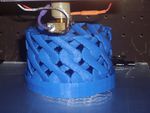 First prototype in action.
(Photo provided by Brian Briggs.)
First prototype in action.
(Photo provided by Brian Briggs.)
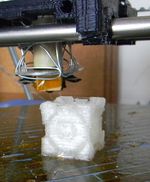 A test print using PLA. A high filament speed was used and there was little tuning of Skeinforge as the goal was to see if the nozzle would print with PLA. (Photo provided by Anthony Aragues.)
A test print using PLA. A high filament speed was used and there was little tuning of Skeinforge as the goal was to see if the nozzle would print with PLA. (Photo provided by Anthony Aragues.)
